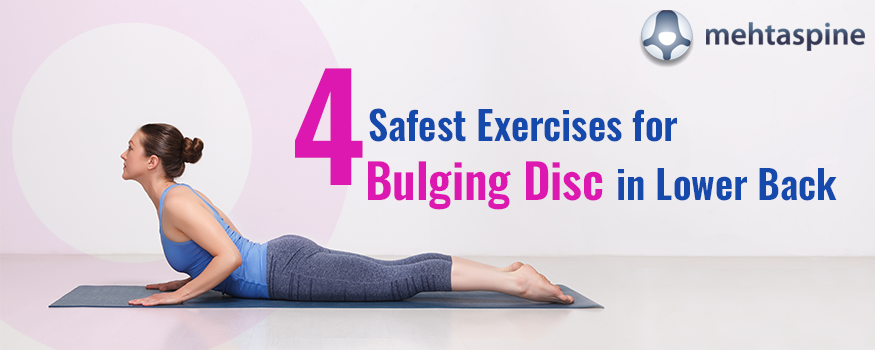4 Safest Exercises for Bulging Disc in Lower Back
A bulging disk is a common spine problem caused when the spinal disk protrudes and begins to extend beyond its normal boundary. These spinal disks that act like cushions protect spinal bones from strain absorb shocks, and enable the spine to flex, bend, and rotate.
When the spinal disk goes out of place even slightly, it may interfere with the other spinal components, leading to nerve compression, muscle weakness, reduced mobility, and even reflex changes, according to spine orthopaedic surgeons & back pain specialists in UK, Mr Jwalant S Mehta.
Bulging Disks & Remedy of Exercises
The problems that these bulging discs cause interfere with everyday function, even preventing people from regular exercising. “However, when carefully chosen, a few exercises can help manage and recover from bulging discs,” says spine surgeon Dr Mehta.
If you are suffering from bulging discs and looking for safe exercises to help alleviate the pain and improve spinal stability, this blog is for you. With the inputs from Children and Adult Spinal Surgeon Mr. Jwalant S. Mehta, we first touch upon the symptoms of bulging discs and then list out exercises that can help reduce and alleviate the symptoms of bulging discs. Read on:
What is a Bulging Disk Problem?
The spine is a column of stacked bones like vertebrae, between which cushion-like discs sit to make a solid backbone structure. These spinal discs are tightly packed with a soft inner core at the center and a hard outer layer surrounding it. The discs protrude and bulge when the outer core is weakened, pushing the soft inner core against the outer layer and, as a result, bulge.
Given our lower back’s significant role in every exercise, a bulging disc in the lower back can interfere with every movement. In this blog, we have mainly concentrated on lower back exercises that can ease the debilitating pain. Here’s the list:
Cat-Cow:
Cat-cow is the most effective herniated disc exercise for relieving the pressure on the herniated side. This exercise opens up the intervertebral space, which improves the spine’s mobility, reduces pain, and enhances the pace of recovery.
Procedure for Cat-Cow:
- Perform this stretch by placing your hands and knees on the floor.
- Inhale, arch your back and look up. Exhale, round your spine, and look down.
- Do ten reps for 2-3 sets.
Standing Extension:
This is the most straightforward exercise of the lot that sorts the discs into a neutral position and corrects the hunch in the back.
Procedure for standing stretch:
- Stand straight with good posture.
- Place the hands on the lower back, push the pelvis forward, and slowly arch your spine while extending your neck to face the ceiling.
- Perform ten reps for 2-3 sets.
Full Cobra Pose:
This pose also sorts the discs into a normal position to relieve pain and enable healing.
Procedure for Full Cobra Pose:
- Lay on the floor with face and hips on the floor.
- Slowly lift yourself with your hands while keeping your lower back relaxed and pelvis touching the floor.
- Hold the position for 10 seconds and revert to the original – 10 reps are recommended.
Full cobra pose is a slightly advanced lower back exercise for people with bulging disc problems in the lower back. In such cases, the patient may perform a half-cobra pose where one reduces the height to the height one raises.
Spinal Decompression:
The most underrated and overlooked exercise is spinal decompression. This is the best exercise to start for patients suffering from lower back bulging disc problems.
Procedure for Spinal Decompression:
- Find a pull-up bar (or any robust bar) where you can comfortably hang at full scale with your hands.
- The goal of the exercise is to hang off the bar for more than 30 seconds or until your grip gives away.
- Three repetitions of 30 seconds each is the recommended load time.
This simple decompression exercise increases the wound-up spine by increasing the intervertebral space to take the pressure off the discs and relieve the pain.
The above four exercises are simple disc herniation exercises that can improve spinal mobility and stability while gradually relieving pain. One is prescribed to try for the recommended workload; if not, slowly build to the respective load to gain the full benefits of the above exercises. If you have been performing the above exercises but cannot see progress in the condition, it could be an inherent problem that needs local attention and evaluation from a specialist spine surgeon who can recommend a customized treatment plan and recovery. If you live in Birmingham, you can contact leading back pain specialist in UK Mr. Jwalant S. Mehta


